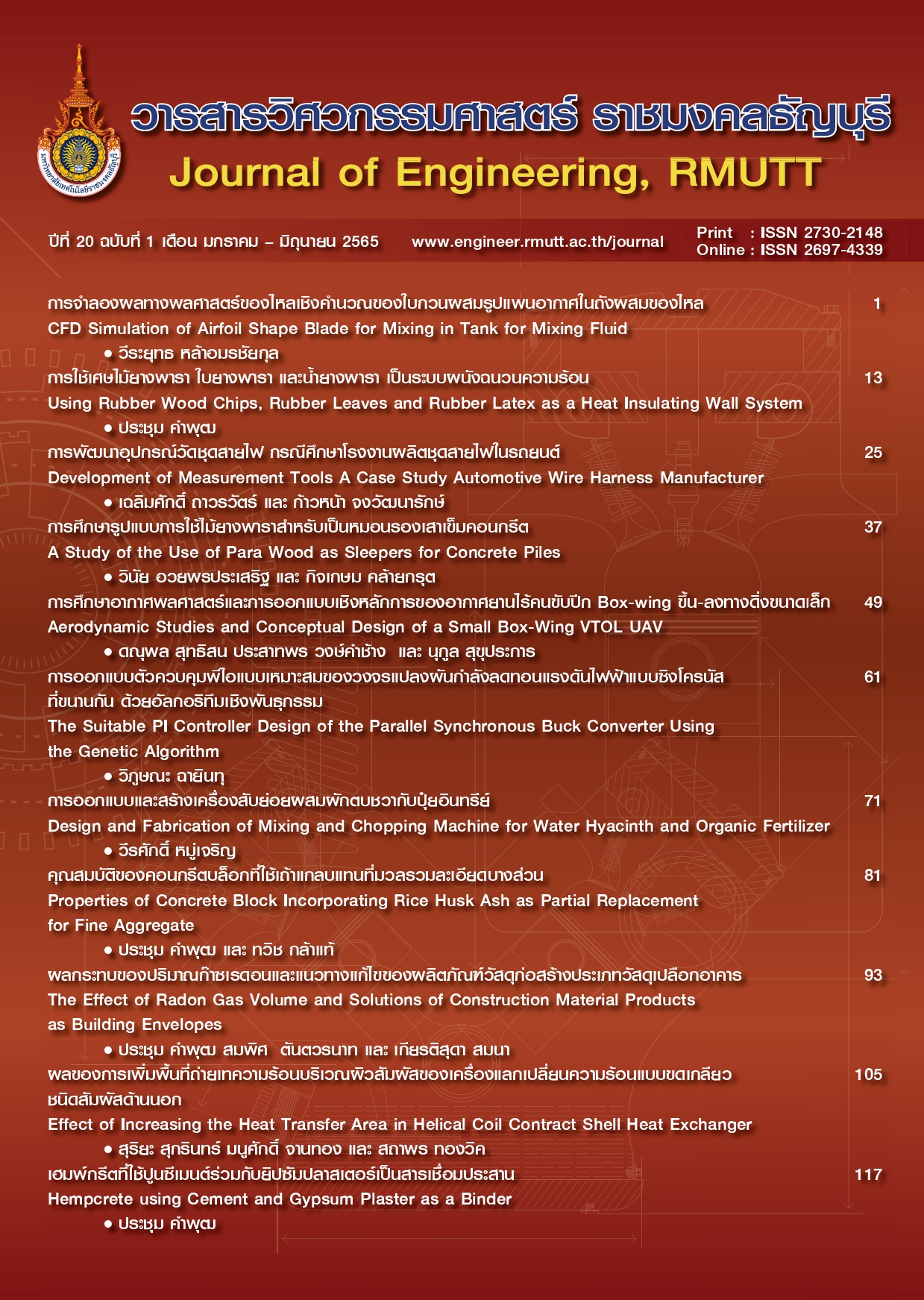Aerodynamic Studies and Conceptual Design of a Small Box-Wing VTOL UAV
Main Article Content
Abstract
This research presents a study of the aerodynamics of a small box-wing vertical take-off and landing unmanned aerial vehicle with the airfoil S3010, which has a high lift coefficient from the results of a comparison of the airfoils commonly used in small UAV design by the XFLR5 program. This airfoil was used for the modeling of baseline mono-plane UAV and box-wing UAV to compare the aerodynamic characteristics using computational fluid dynamics methods. The results show that box-wing UAVs had a 9.43% higher lift-to-drag than mono-plane UAVs at a cruising speed of 17.5 m/s and an angle of attack of 0°. As the results, the installation of tilt motor has been proposed for the further proceeding in the preliminary design phase.
Article Details

This work is licensed under a Creative Commons Attribution-NonCommercial-NoDerivatives 4.0 International License.
The manuscript, information, content, picture and so forth which were published on Frontiers in engineering innovation research has been a copyright of this journal only. There is not allow anyone or any organize to duplicate all content or some document for unethical publication.
References
Posew K, Ananchaipattana CH. Pelton turbine efficiency analysis using computational fluid dynamics technique. Journal of Engineering, RMUTT. 2016;14(2):11-9. (in Thai)
Sreelakshmi K, Jagadeeswar K. Aerodynamic analysis over Unmanned Aerial Vehicle (UAV) using CFD. IOP Conf. Ser.: Mater. Sci. Eng. 2018;455
Austin R. Unmanned aircraft systems : UAVS design, development and deployment. John Wiley & Sons Ltd; 2010.
Winslow J, Otsuka H, Govindarajan B, Chopra I. Basic understanding of airfoil characteristics at low reynolds numbers (104-105). Journal of Aircraft 2018;55(3):1050-61
Kroo I. Nonplanar wing concepts for increased aircraft efficiency. Innovative configurations and advanced concepts for future civil aircraft. 2005.
Prandtl L. Induced Drag of Multiplanes. NACA Technical Report No. 182. National Advisory Committee for Aeronautics. 1924.
Manikantissar, Geete A. CFD analysis of conceptual aircraft body. Int. J. Eng. Technol. 2017;4(1):217-22
Menter F R. Two-equation eddy-viscosity turbulence models for engineering applications. AIAA J. 1994;32(8):1598-605
Palaia G, Cipolla V, Binante V, Rizzo E. Preliminary design of a box-wing VTOL UAV. Aircr. Eng. Aerosp. Technol. 2019;92(5):737–43.
Ma T, Wang X, Wei Z, Zihan X, Bie D. Conceptual design of a VTOL box-wing UAV with rotatable duct-fans. AIAA Scitech Forum. 2019.
Chau T, Zingg D W. Aerodynamic shape optimization of a box-wing regional aircraft based on the Reynolds-Averaged Navier-Stokes equations. 35th AIAA Applied Aerodynamics Conference. 2017.
Andrews S A, Perez R E. Comparison of box-wing and conventional aircraft mission performance using multidisciplinary analysis and optimization. Aerosp Sci Technol. 2018;79:336–51.
Kaparos P, Papadopoulos C, Yakinthos K. Conceptual design methodology of a box wing aircraft: A novel commercial airliner. Proc Inst Mech Eng G J Aerosp Eng. 2018:1-12.
Kody F, Bramesfeld G. Small UAV design using an integrated design tool. Int. J. Micro Air Veh. 2012;4(2):151–63.
Hamburg S D. Conceptual and preliminary design of a stowable ruggedized micro air vehicle [graduate Thesis]. Morgantown, WV: West Virginia University; 2010.
Silverstein A. Scale effect on Clark Y airfoil characteristics from NACA full-scale wind-tunnel tests. NACA Technical Report No. 502. National Advisory Committee for Aeronautics. 1934.
Seubert C A. Analysis of a Goldschmied Propulsor using computational fluid dynamics referencing California Polytechnic’s Goldschmied Propulsor testing [master’s thesis]. San Luis Obispo, CA : California Polytechnic State University; 2012.
Bacchini A. Electric VTOL preliminary design and wind tunnel tests [dissertation]. Torino TO, Italy: Politecnico di Torino; 2020.


